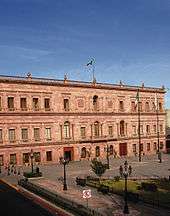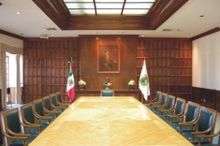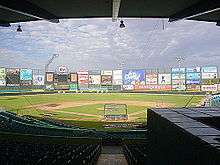Saltillo
| Saltillo | ||
|---|---|---|
| City | ||
 City of Saltillo | ||
| ||
| Nickname(s): The Athens of Mexico, The Detroit of Mexico | ||
 Location of Saltillo within the municipality | ||
| Coordinates: 25°26′N 101°00′W / 25.433°N 101.000°WCoordinates: 25°26′N 101°00′W / 25.433°N 101.000°W | ||
| Country |
| |
| State |
| |
| Founded | July 25, 1577 | |
| Founded as | Villa de Santiago del Saltillo | |
| Founded by | Alberto del Canto | |
| Government | ||
| • Mayor | Isidro López Villarreal | |
| Elevation | 1,600 m (5,250 ft) | |
| Population (2015) | ||
| • City | 807,537 [1] | |
| • Metro | 923,636 [1] | |
| • Demonym | Saltillense | |
| Time zone | UTC−6 (CST) | |
| • Summer (DST) | UTC−5 (CDT) | |
| Website | www.saltillo.gob.mx | |
Saltillo (Spanish pronunciation: [salˈtiʝo] (![]()
Saltillo is one of the most industrialized areas of the country and has one of the largest automotive clusters in Mexico, with plants such as Grupo Industrial Saltillo, General Motors, Fiat Group, Chrysler, Daimler, Freightliner, Delphi, Plastic Omnium, Magna, and Nemak been installed in the region. In 2013, the FDi Intelligence Magazine placed the capital of Coahuila as the best medium-sized city with the best economic potential to invest in Latin America.
The first union between two people of the same sex in Latin America was made in Saltillo. This happened on January 2007, when two women united through the Civil Pact of Solidarity,
History

Founded in 1577 by Conquistador Alberto del Canto and Spanish colonists, Saltillo is the oldest post-conquest settlement in northern Mexico. Fourteen years later in 1591 the Spanish resettled a community of their Tlaxcaltec allies in a separate nearby village (San Esteban de Nueva Tlaxcala), in order to cultivate the land and aid colonization efforts that had stalled in the face of local hostility to the Spanish presence.[2][3]
Saltillo was a northern commercial center on the northern frontier which served as a bridge from central Mexico to regions farther northeast, Nuevo León, Nuevo Santander, Coahuila, and Texas.[4] Saltillo supplied the silver mines of Zacatecas with wheat.[5] It never rose to great prominence, but it did develop a commercial core and an agricultural and ranching sector that supplied its own needs, with surpluses that could be sold. Saltillo became administratively more important at the end of the eighteenth century, with the establishment of a branch of the Royal Treasury.[6] Merchants, most of whom were Iberian-born peninsular Spaniards, constituted the most important economic group, handling a wide variety of goods and sold in shops.[7] They were the provincial branch of the transatlantic merchant sector, with ties to Mexico City merchants. Peninsular merchants in Saltillo married into local elite society, acquired rural properties, and sought local office.[8] In the late seventeenth century, an annual trade fair was established, with goods from as far away as China and Europe, but also Mexican manufactures and livestock. Saltillo could produce wheat commercially so long as enterprises had access to water, but as with many other parts of the North, drought was a consistent threat. In the eighteenth century, there was a demand for draft animals, which Saltillo could supply.[9]
In 1824, Saltillo was made the capital of the State of Coahuila y Tejas and included the area which is now the U.S. state of Texas until the Texas War of Independence and the founding of the independent Texas Republic.
On 23 October 1840 the Battle of Saltillo took place when 110 Texans and Tejanos crossed the Rio Grande and attacked the city, as part of a campaign to establish the Republic of the Rio Grande, a separatist rebellion in northeastern Mexico which had Texan support.[10]
Government
The city of Saltillo is the municipal seat of the municipality of Saltillo. The current Mayor is Manolo Jiménez Salinas from the Partido Revolucionario Institucional (PRI).
Geography
El Cerro del Pueblo (The People's Hill) and its 4-metre (13 ft) cross overlook the city. The city's elevation makes it cooler and windier than the neighboring city of Monterrey. Saltillo lies near the city of Arteaga and in the Chihuahuan Desert. The city is flanked by the Zapalinamé mountains, which are part of the Sierra Madre Oriental. By looking at the relief of the mountains, one can see, according to local legend, the relief of Zapalinamé, chieftain of the Guachichil tribe.
Climate
Saltillo has a semi-arid climate (Köppen climate classification BSh, just avoiding arid designation). Saltillo is located in the Chihuahuan Desert but temperatures are cooler than other desert cities in Mexico because it is located in an altitude of 1,600 meters (5,250 ft). Summers are slightly hot with cool nights, and winters are sunny but cool. Rainfall is scarce but more prominent in summer.
| Climate data for Saltillo (1951–2010) | |||||||||||||
|---|---|---|---|---|---|---|---|---|---|---|---|---|---|
| Month | Jan | Feb | Mar | Apr | May | Jun | Jul | Aug | Sep | Oct | Nov | Dec | Year |
| Record high °C (°F) | 36.5 (97.7) |
33.0 (91.4) |
36.5 (97.7) |
39.0 (102.2) |
40.5 (104.9) |
40.5 (104.9) |
39.5 (103.1) |
37.0 (98.6) |
38.5 (101.3) |
39.0 (102.2) |
34.5 (94.1) |
31.0 (87.8) |
40.5 (104.9) |
| Average high °C (°F) | 19.7 (67.5) |
21.4 (70.5) |
24.7 (76.5) |
27.9 (82.2) |
29.9 (85.8) |
30.2 (86.4) |
29.7 (85.5) |
29.2 (84.6) |
26.7 (80.1) |
24.8 (76.6) |
22.5 (72.5) |
20.0 (68) |
25.6 (78.1) |
| Daily mean °C (°F) | 12.1 (53.8) |
13.6 (56.5) |
16.8 (62.2) |
20.0 (68) |
22.3 (72.1) |
23.2 (73.8) |
23.0 (73.4) |
22.6 (72.7) |
20.3 (68.5) |
18.0 (64.4) |
15.2 (59.4) |
12.7 (54.9) |
18.3 (64.9) |
| Average low °C (°F) | 4.5 (40.1) |
5.7 (42.3) |
8.8 (47.8) |
12.1 (53.8) |
14.8 (58.6) |
16.1 (61) |
16.3 (61.3) |
15.9 (60.6) |
14.0 (57.2) |
11.2 (52.2) |
7.8 (46) |
5.5 (41.9) |
11.1 (52) |
| Record low °C (°F) | −14.5 (5.9) |
−10.5 (13.1) |
−6.0 (21.2) |
0.0 (32) |
0.5 (32.9) |
6.5 (43.7) |
4.0 (39.2) |
8.0 (46.4) |
1.3 (34.3) |
−3.0 (26.6) |
−5.0 (23) |
−11.0 (12.2) |
−14.5 (5.9) |
| Average rainfall mm (inches) | 15.8 (0.622) |
12.3 (0.484) |
8.2 (0.323) |
15.2 (0.598) |
30.5 (1.201) |
47.0 (1.85) |
61.4 (2.417) |
58.6 (2.307) |
62.5 (2.461) |
31.1 (1.224) |
12.2 (0.48) |
14.5 (0.571) |
369.3 (14.538) |
| Average rainy days (≥ 0.1 mm) | 3.4 | 2.7 | 2.0 | 3.4 | 5.1 | 6.3 | 8.8 | 9.2 | 7.9 | 5.1 | 3.0 | 3.3 | 60.2 |
| Average snowy days | 0.1 | 0.0 | 0.0 | 0.0 | 0.0 | 0.0 | 0.0 | 0.0 | 0.0 | 0.0 | 0.0 | 0.2 | 0.3 |
| Average relative humidity (%) | 55 | 52 | 48 | 50 | 55 | 59 | 62 | 64 | 69 | 66 | 60 | 59 | 58 |
| Mean monthly sunshine hours | 169.5 | 174.8 | 195.4 | 182.3 | 209.1 | 215.8 | 205.7 | 199.3 | 169.4 | 186.0 | 176.7 | 152.4 | 2,236.4 |
| Source #1: Servicio Meteorologico Nacional[11][12] | |||||||||||||
| Source #2: Colegio de Postgraduados[13][14] | |||||||||||||
Economy

Saltillo's most famous exports are Saltillo tile and the locally woven multi-coloured sarapes. Mercedes-Benz and General Motors both have assembly plants here and Chrysler operates a truck assembly plant, a sedan assembly plant, two engine facilities and a car transmissions plant. 37.4% of cars and 62.6% of trucks produced in Mexico are assembled in Saltillo.[15] Saltillo is home to the Grupo Industrial Saltillo, an important manufacturing conglomerate that makes home appliances, silverware, and auto parts.
During the early 20th century, Saltillo was called the Athens of Mexico because of its number of famous intellectuals. At that time, Saltillo was inhabited by a large number of expatriates from Europe, particularly Great Britain and Ireland. It is currently considered the Detroit of Mexico because of the importance of its automotive industry, including the huge Chrysler, General Motors, and Delphi plants.
The General Motors plant, the Complejo Industrial Ramos Arizpe (Ramos Arizpe Industrial Complex) manufactures vehicles for export to Japan, Canada, and Central America as well as for domestic purchase. It builds the Chevrolet C2, Chevrolet Monza, Chevrolet Captiva, Chevrolet HHR, Saturn Vue hybrid, Saab 9-4X and Cadillac SRX.[16] As of 2016 the plant produces about one third of the firm's full-sized pickups.[17]
Points of interest


Alameda Zaragoza, located just west of the downtown plaza, has a pond in the shape of the Mexican Republic.
The Colonial Center of the city is built in pink marble, giving Saltillo's architecture a distinctive flavor. Prominent buildings are the cathedral (built from 1745-1800), the Palacio de Gobierno (state government building), the Ateneo Fuente and the Instituto Tecnológico de Saltillo. The large cathedral is the best example of colonial religious architecture in northeastern Mexico; its facade is mainly Spanish Baroque, with less exuberant areas. The Centro Cultural Vito Alessio Robles (Vito Alessio Cultural Center) is an 18th-century repository of antiquities and documents from historians Vito Alessio Robles and Oscar Davila. The repository is also a temporal museum. The Casa Purcell (Purcell Manor) is a Victorian style mansion built in the 19th century by Irish merchant William Purcell. Today it is a cultural center. Next to Casa Purcell, is Banco Purcell which is also a cultural center.
The city has two world-class museums. The Museo de las Aves de México (Bird Museum),[18] featuring a collection of bird specimens from all over Mexico in realistic displays. The Museo del Desierto (Desert Museum)[19] focuses on the geography, geology, paleontology (with dinosaur fossils) and biodiversity of the Chihuahuan Desert, and the history and culture of the local people through time. It includes a cactus greenhouse and exhibits, with dozens of species.
The Mirador is an amazing place to observe a panoramic view of the city. Underground tunnels start in the Catedral de Santiago and end at the city's limits.
Education


Saltillo's main universities are the Universidad Autónoma de Coahuila, the Instituto Tecnológico de Saltillo, the Tec de Monterrey Saltillo Campus, El Instituto de Filologia Hispanica, and the Universidad Autónoma Agraria Antonio Narro. Other universities include Centro de Investigaciones y Estudios Avanzados del IPN (CINVESTAV Saltillo), Universidad Interamericana del Norte (Tec Sierra Madre , Universidad Autonoma del Noreste, Universidad Pedagogica Nacional, Universidad del Valle de Mexico, Escuela Normal de Coahuila , and many others.
Transportation
Saltillo Metropolitan Area air traffic is served by Plan de Guadalupe International Airport. It takes 15 minutes to get from downtown Saltillo to the airport. It has several flights per day to Mexico City and no flights to international locations. There is a comprehensive bus system in Saltillo along with many taxis.
Sister cities
The following are sister cities of Saltillo:





People
- Fernando Soler (1896–1979), film actor and director
- Rubén Aguirre, actor best remembered for his characterization of Professor Jirafales in the television show El Chavo del Ocho.
- Magda Guzman, actress with many film and TV credits 1941 to the present[21]
- Roberto 'Flaco' Guzman, prolific film actor from the 1970s to the early 2000s.
- Brissia Mayagoitia, singer, former member of a band called La Nueva Banda.
- Rosario Ybarra, activist and prominent figure in Mexican politics.
- Carlos Bee, former U.S. Representative from Texas, son of Hamilton Bee, great-grandson of Thomas Bee.
- Manuel Acuña, 19th-century Mexican writer. He focused on poetry, but also wrote some novels and plays.
- José Narro Robles, former director of the Faculty of Medicine of the National Autonomous University of Mexico.
- Roque González Garza, Mexican general and acting president of the Republic from January to June 1915.
- Julio Torri, Mexican writer and teacher who formed part of the Ateneo de la Juventud (1909-1914).
- Josip Lovaković, footballer, currently playing for Atlante F.C. of Croatian descent
- Checo Marrero, Engineer and philosopher, creator of the square ball. Most famous quotes: “Vámonos marimba al baile” “No Pos Guau” “Y arriba el cemento”
References
- 1 2 3 "Número de habitantes. Coahuila de Zaragoza". www.cuentame.inegi.org.mx.
- ↑ Offutt (2001), p. 55
- ↑ INAFED (Instituto Nacional para el Federalismo y el Desarrollo Municipal) (2005). "Saltillo, Coahuila". Enciclopedia de los Municipios de México (in Spanish) (online version at E-Local ed.). Secretaría de Gobernación. Archived from the original on May 20, 2007. Retrieved 2008-03-28. . The Tlaxcalteca community remained legally separate until the 19th century.
- ↑ Offutt (2001)
- ↑ Offutt (2001), p. 187
- ↑ Offutt (2001), p. 9
- ↑ Offutt (2001), p. 10
- ↑ Offutt (2001), p. 50
- ↑ Offutt (2001), p. 100
- ↑ Brown (1893), pp. 173–174
- ↑ NORMALES CLIMATOLÓGICAS 1951-2010 Archived March 3, 2016, at the Wayback Machine., National Meteorological Service of Mexico. Retrieved August 30, 2012
- ↑ "Extreme Temperatures and Precipitation for Saltillo 1949-2008" (in Spanish). National Meteorological Service of Mexico. Archived from the original on March 3, 2016. Retrieved January 21, 2013.
- ↑ "Normales climatológicas para el Estado de Coahulia". Colegio de Postgraduados. Retrieved 18 September 2012.
- ↑ "Normales climatológicas para Saltillo, Coahulia" (in Spanish). Colegio de Postgraduados. Archived from the original on February 21, 2013. Retrieved January 8, 2013.
- ↑ "COAHUILA, PRIMER LUGAR NACIONAL EN PRODUCCIÓN AUTOMOTRIZ". Retrieved 2007-12-01.
- ↑ Priddle, Alisa (June 2008). "2008 Saab 9-3 Turbo X is Nearly Sold Out". Car and Driver.
- ↑ Bill Vlasic (February 13, 2017). "Profitable Pickups May Be in Cross Hairs of Trump Border Tax". The New York Times. Retrieved February 14, 2017.
And while Fiat Chrysler is expanding its American output of trucks, it still relies on its factory in Saltillo, Mexico, for 30 to 40 percent of its pickups
- ↑ "Museo de las Aves de México". Retrieved 2007-12-01.
- ↑ "Museo del Desierto". Retrieved 2007-12-01.
- ↑ Torres, Robert (2009-12-25). "Canton creating Sister Cities in Israel, Mexico to encourage investment". cantonohio.gov. Director of Development. Retrieved 2015-01-23.
- ↑ "Magda Guzmán". The Internet Movie Database. Retrieved 2011-10-27.
Bibliography
- Brown, John Henry (1893). History of Texas: From 1685 to 1892. 2. Princeton University: L. E. Daniell.
- Offutt, Leslie S. (2001). Saltillo 1770–1810: Town and Region in the Mexican North. Tucson, AZ: University of Arizona Press. ISBN 978-0-8165-2164-7.
External links


- Link to tables of population data from Census of 2005 INEGI: Instituto Nacional de Estadística, Geografía e Informática.
- Official city website



